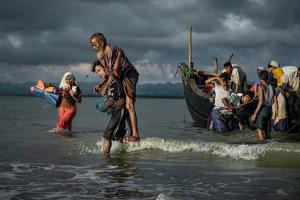Original Print | Oct 1, 2017 | The Caravan Magazine
 On 14 September, an Indian Air Force aircraft landed in Chittagong with 53 tonnes of relief materials, including food, salt, cooking oil and mosquito nets. The delivery was meant to help Bangladesh cope with the vast influx of Rohingyas—a minority community in Myanmar that is facing large-scale violence there. This was the first tranche of assistance India said it would provide, as the refugees continued to arrive, crossing the Naf—the river that marks the border of south-eastern Bangladesh and western Myanmar—and swelling overcrowded, makeshift camps that have emerged on a narrow strip of land that faces the Bay of Bengal to its east. India has pledged to deliver 7,000 tonnes of aid.
On 14 September, an Indian Air Force aircraft landed in Chittagong with 53 tonnes of relief materials, including food, salt, cooking oil and mosquito nets. The delivery was meant to help Bangladesh cope with the vast influx of Rohingyas—a minority community in Myanmar that is facing large-scale violence there. This was the first tranche of assistance India said it would provide, as the refugees continued to arrive, crossing the Naf—the river that marks the border of south-eastern Bangladesh and western Myanmar—and swelling overcrowded, makeshift camps that have emerged on a narrow strip of land that faces the Bay of Bengal to its east. India has pledged to deliver 7,000 tonnes of aid.
The gesture had an immediate effect. Bangladesh shed its apprehension about hosting more refugees and opened its doors. Its prime minister, Sheikh Hasina Wazed, said that her country can feed the anticipated hundreds of thousands of people, given that it could already look after its 160 million citizens.
India’s generosity, however, was a departure from how the country had seen the Rohingya crisis barely a month earlier. On 8 August, India’s home ministry issued an advisory that asked all state governments to take prompt steps in “identifying the illegal migrants and initiate deportation processes expeditiously and without delay.” The advisory did not name the Rohingya, some 40,000 of whom are living in India right now, but referred to “infiltration from Rakhine state of Myanmar,” which it said posed “grave security challenges” to the country. On 1 September, two Rohingya men, with help from the lawyer Prashant Bhushan, filed a plea challenging the advisory, and the Supreme Court is hearing the matter. On 18 September, Home Minister Rajnath Singh said that the government would abide by the Supreme Court’s verdict, thus passing the decision of whether the Rohingya will be deported on to the judges.
The initial hostile stance of the BJP government, evident in the advisory, spoke to its Hindu-nationalist followers, who are largely unsympathetic to the predominantly Muslim Rohingya, with some even spreading lies about the community on social media. India initially tried to align itself with the Myanmarese government, which has painted the community as one of violent secessionists. But this position on the crisis became increasingly untenable for the Bharatiya Janata Party government over the next few weeks. Not only did the view have few takers in the international community, but also by endorsing it, India risked alienating Bangladesh—a valuable ally in the region. Though the government continues to argue against recognition of the Rohingya as refugees in court, many see the assistance now being provided to the community as India softening its stand, after having shown little understanding of a complex and sensitive issue.
The history of the Rohingya crisis goes at least as far back as Partition. For centuries, the Rohingya lived on land that is now part of Myanmar and Bangladesh. They have been settled across a territory that is now divided by an international border, but which was ruled from Delhi during the British Raj. Myanmar, then known as Burma, was separated from British India in 1937. During Partition, Rohingya leaders sought to join what was then East Pakistan, but Pakistan’s founding father, Muhammad Ali Jinnah, did not let them do so. After Bangladesh became independent, Burma asked the newly independent country to take the Rohingya in, but Bangladesh refused. In 1978, the Burmese army launched Operation Nagamin, or dragon king, to fight a weak Rohingya insurgency, leading to the first of several mass evictions of the Rohingya from Burma into Bangladesh. Such acts of ethnic cleansing continued in the subsequent decades.
